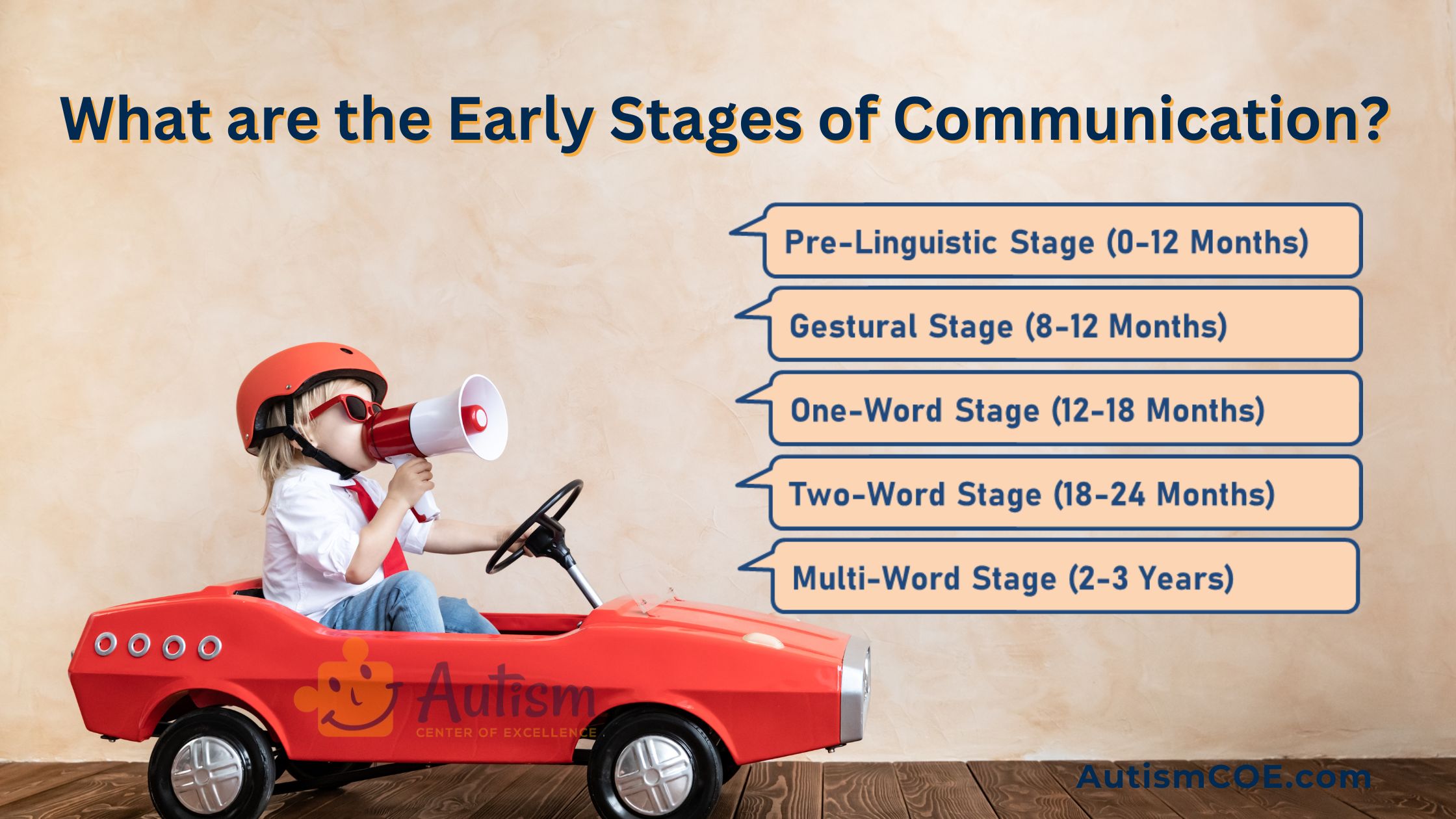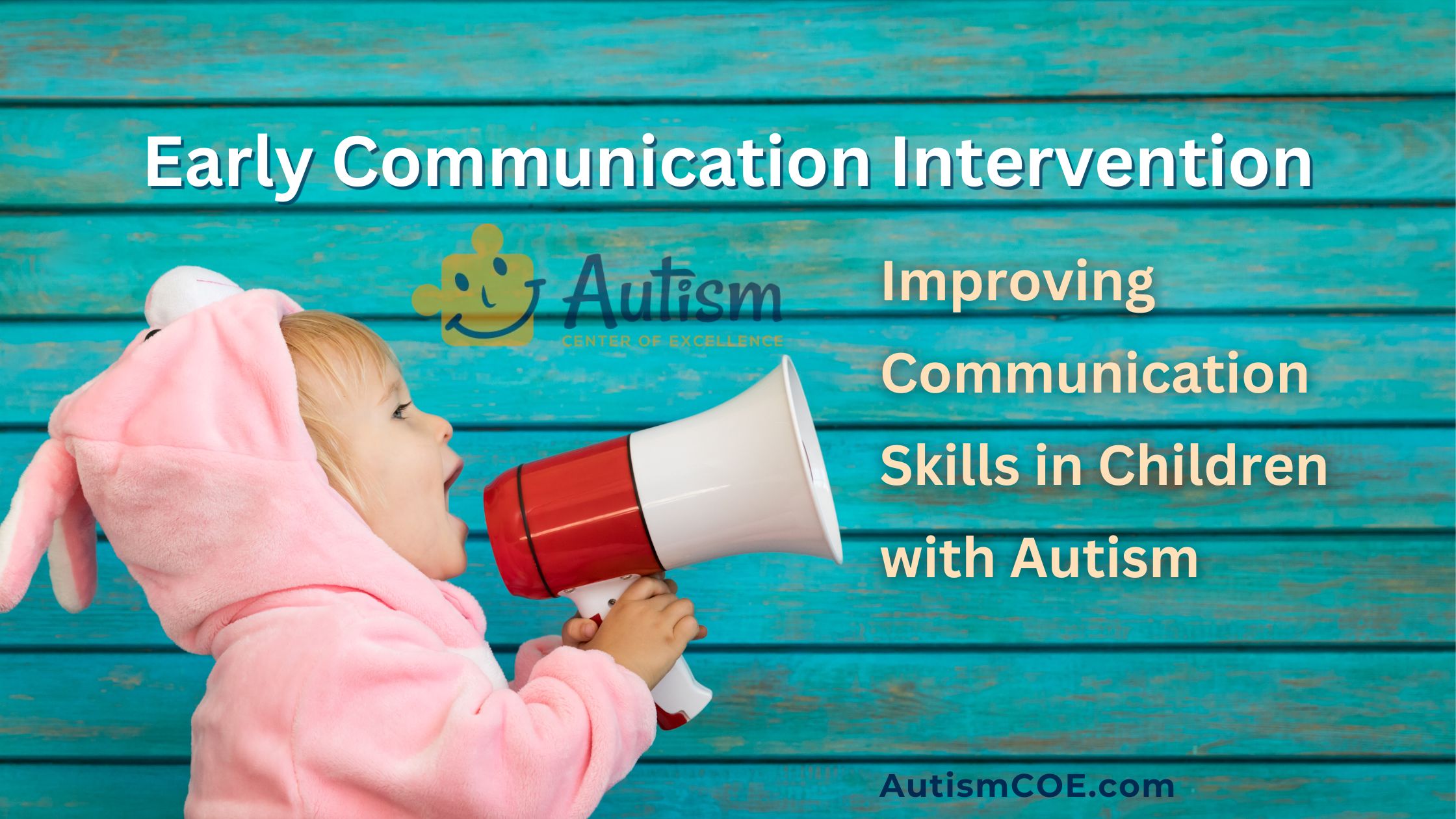Communication is the foundation of human communication, through which our perception & position is determined in this world. The building of effective communication skills in a child from childhood period is the most important thing for him to become a successful person socially, academically, or converting in this profession in the future. Nevertheless, some children might struggle to develop these skills because of such conditions as Autism Spectrum Disorder (ASD), Down Syndrome, or other developmental delays. Such is the role of Early Communication Intervention.
In this blog article, we discuss early communication intervention and how it promotes the development of children. We will look at the important role of Applied Behavior Analysis (ABA) therapy which is a prevalent method in early communication intervention. We will also respond to some common inquiries concerning early communication intervention, which makes this article an easy-to-use referential material for parents, caregivers, and teachers. Participate with us as we discuss this important part of child development and learn about how Early Intervention can have a positive influence on a child’s life.
Early communication intervention is a set of therapeutic approaches aimed at improving the language and communication skills of children, especially those with developmental disorders like autism. These interventions are mainly aimed at promoting the development of functional communication skills as early as possible.
Some of the early comprehensive communication interventions for children with ASD may involve approaches like Speech-Language Therapy, augmentative and alternative communication (AAC), social skills training, and so on. Such interventions are usually individualized depending on the need and capacity of each child and are aimed at the development of both verbal and non-verbal communication skills.
The main philosophy of early intervention is that the brain is more interactive, so the children should be treated with this teaching model. Thus, early identification, assessment, and recommendation for Speech Delay or other communication disorders can be very beneficial. It is a chance to equip children with what they need to communicate what they feel and understand what others are saying, thereby, ensuring that they successfully interact for the rest of their lives.

What are the Early Stages of Communication?
The early phases of communication development in children lay a cornerstone of their social interaction and ability to communicate. This progression usually starts at the time of birth and goes on as they develop and age. Here’s a brief overview of these crucial stages:
👶 Pre-Linguistic Stage (0-12 Months)
The communication of the babies during this stage is mostly through non-verbal, such as crying, cooing, babbling, and facial expressions. They learn the value of communication through the fact that their noise or cries can be captured by the caregiver’s attention.
👶 Gestural Stage (8-12 Months)
As infants grow, they start using gestures to communicate. This includes waving goodbye, pointing at objects, or shaking their head to mean ‘no’. These gestures represent an Important Milestone in early Communication Development as they show an awareness of purposeful communication.
🧒 One-Word Stage (12-18 Months)
In this phase, children start using single words to communicate whole concepts. Such as calling “ball” could mean either “look at the ball”, “I need the ball” or “ball is rolling.”
🧒 Two-Word Stage (18-24 Months)
Here, children start combining two words to form simple phrases, such as “more juice” or “Daddy is gone”. This stage demonstrates an understanding of basic grammar rules.
🧒 Multi-Word Stage (2-3 Years)
Children begin to form more complex sentences, expanding their vocabulary rapidly. They start to ask questions and can engage in simple conversations.
Recognizing these stages and identifying any delays is crucial in early communication intervention. In Children with ASD, these stages may not follow the typical timeline or sequence. For instance, a child might skip the gestural stage or have a delay in moving to the multi-word stage.

Major Aspects of Early Intervention to Improve Communication in Autism
Intervention programs for children with autism spectrum disorder (ASD) are aimed at Enhancing Communication, social skills, and adaptive behaviors. Such interventions are vitally important as they can ensure more favorable long-term results. Here are some of the major aspects of early intervention for Communication Disorders:
Increasing the Frequency, Form, and Function of Communicative Acts
Intervention strategies are intended to improve the frequency, form, and function of communicative acts. This is promoting children with autism to communicate frequently (frequency), in diverse ways (form), and for various reasons (function). Prompting, modeling, reinforcement, and feedback are some of the strategies that are frequently employed.
Developmental Pragmatic Approach
This approach is a central component of early communication intervention in children with ASD. It involves adjusting the intervention strategies to the child’s level of development and individual needs. The attention is given to the development of free and integrated communication in real life rather than repetition learning.
Enhancing Non-verbal Communication
Non-verbal communication is an important part of human interaction. Therefore, early intervention programs usually comprise approaches aimed at non-verbal communication development, which implies knowledge and use of body language, facial expressions, and gestures.
Improving Social Skills
Working alongside social skills, early intervention programs are also set to improve communication skills. This also involves teaching children with autism how to interpret and act on social cues, share attention, take turns, and participate in reciprocal interactions.
Promoting Independence and Adaptive Behaviors
Early intervention can encourage children with autism to acquire self-care capabilities, independence, and adaptive behaviors. This includes educating them on being able to do daily activities on their own, act in a socially acceptable manner in different environments, and be more tolerant of changes in their lives.
The success of any early intervention program is based mainly on its intensity and the active participation of parents or caregivers. Thus, Families require the essential training and support to execute these strategies at home.
Benefits of Early Communication Intervention
Early intervention in communication has a big effect on the development of a child, especially if a child has autism or other developmental delay. Here are some key benefits:
1️⃣ Improves Language Skills:
Language skills which include vocabulary, sentence structure, and conversational abilities can be enhanced by early intervention. The feature also improves nonverbal communication by appreciating and utilizing body language, facial expressions, and gestures.
2️⃣ Enhances Social Interaction:
Social skills are also enhanced by communication skill improvement that comes with early intervention. Children learn to interpret social signs and respond with the appropriate actions, share attention, take turns participating in the group, and get involved in interactions, whether initiated by them or by others.
3️⃣ Boosts Cognitive Development:
Cognitive Development is closely associated with Communication Skills. Early intervention can aid in enhancing language skills that lead to improvement in a child’s thinking, problem-solving, and learning abilities.
4️⃣ Promotes Academic Success:
Good communication is vital for academic achievement. Children, who get early intervention, usually do well in school since they can follow directions, ask and answer questions, and engage in classroom discussions.
5️⃣ Improves Behavioral Outcomes:
Problems in communication may result in irritation and behavioral problems. Early intervention prevents children from developing behavioral problems based on the fact that they are able to express their needs and emotions better.
6️⃣ Supports Emotional Development:
Communication also promotes Emotional Development. Children develop the ability to interpret and express their feelings, as well as show empathy to others.
7️⃣ Increases Independence:
Self-care skills, independence, and adaptive behaviors are usually part of the strategies in early intervention programs. This promotes the child’s independence in doing activities of daily living and ability to respond to changes in their environment.
8️⃣ Provides Family Support:
The intervention has a bit broader benefit than the child only. Parents and caregivers are trained and guided on how to facilitate communication development at home.
Join Our Weekly Newsletters!
Subscribe now to stay updated with our latest email updates.

ABA Therapy for Early Communication Intervention
Applied Behavior Analysis (ABA) therapy is a cornerstone intervention for children who are diagnosed with Autism Spectrum Disorder (ASD). It is a scientific method of studying behavior and how it can be changed and it is grounded on the principles of learning and conditioning. A central objective of ABA Therapy is to reduce challenging behaviors and promote functional ones, particularly communication skills.
Children involved in early intervention ABA therapy are able to acquire crucial developmental skills such as communication. The treatment that can even last for years is highly intensive, with children receiving ABA-Based Early Intervention for a period of up to 40 hours per week. With time, these sessions may also turn out to be briefer and specific. ABA therapy works on many communication problems including autism, but also conditions such as Down syndrome and cerebral palsy. Communication skills appropriate to the person’s age and surroundings are a strong base for social interaction, academic success, and overall high quality of life.
Frequently Asked Questions & Answer
Does ABA Therapy Help with Communication?
Yes, the majority of children with Autism Spectrum Disorder (ASD) tend to require the use of Applied Behavior Analysis (ABA) therapy to improve their communication skills. ABA therapy is a method that promotes verbal and non-verbal communication through positive reinforcement of the desired behaviors. This may include teaching children to use words, sign language, or augmentative communication devices to communicate their needs, desires, and emotions.
What is an Example of Early Intervention?
An example of early intervention is a service for toddlers who are starting to exhibit developmental delays. A treatment protocol of that kind may involve language delay treatment through speech therapy, motor skills treatment through physical therapy, and daily leaving skills treatment through occupational therapy. Additionally, social skills training and behavior interventions such as ABA therapy might be part of early intervention for a child with ASD.
What are the Early Communication Efforts by Infants?
Babies begin to communicate from birth using crying, cooing, and eye contact. They start to produce sounds with vowels at about 2-3 months (e.g., “ah-ah” or “oh-oh”). At 6 months, babies begin to babble (using consonants and vowels together), and may start pointing. They also interact in a non-verbal way using their face and body movements.
When Should a Child Start Communicating?
Children start communicating from birth through crying, facial expressions, and body language. They usually start babbling around 6 months and speak their first words around their first birthday. However, all children develop at their own pace, so these milestones do not perfectly align. If you have any worries about your child’s communication development, it is best to consult a healthcare provider or a speech-language pathologist.
Conclusion
Early intervention for such speech and language impairments can be very helpful. It provides professionals the opportunity to handle matters promptly by using interventions that are designed for the child’s particular needs and the current level of communication development. This is especially critical in early communication Intervention for Autism, as individualized strategies are always very successful. We should work towards a world where preventive measures and complete service systems are accessible to everybody, thus developing everyone’s potential and making society more inclusive.
Please Note: The content of this blog is for informational purposes only and should not be considered a substitute for professional medical advice, diagnosis, or treatment. Consult a qualified healthcare professional for personalized guidance tailored to your specific situation.

Bhavika Bhasin
Bhavika Bhasin is the Research and Marketing officer at AutismCOE. She works with children and adults with ASD. Her clinical research includes evaluating various available autism screening and diagnosis methods and their efficacy. She is currently developing a novel screening exam that is indicated to be more accurate than the existing available exams. She is also writes articles papers for various publications.


